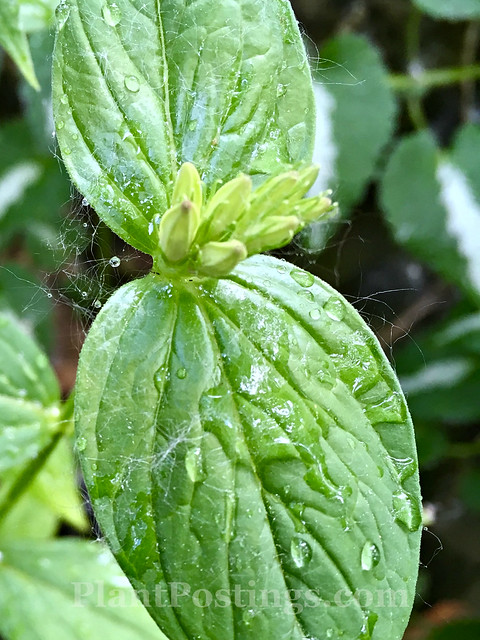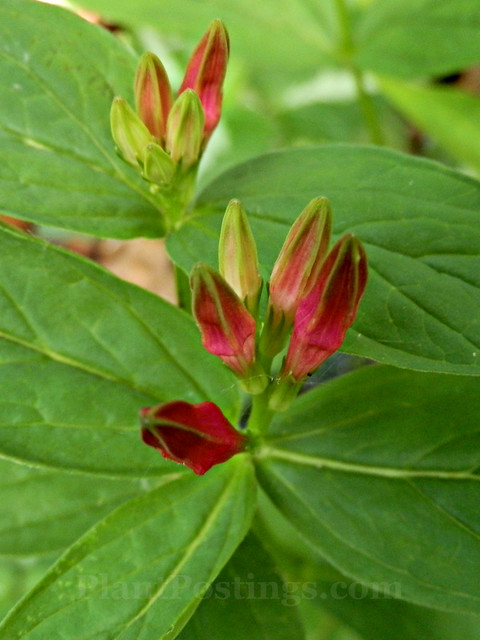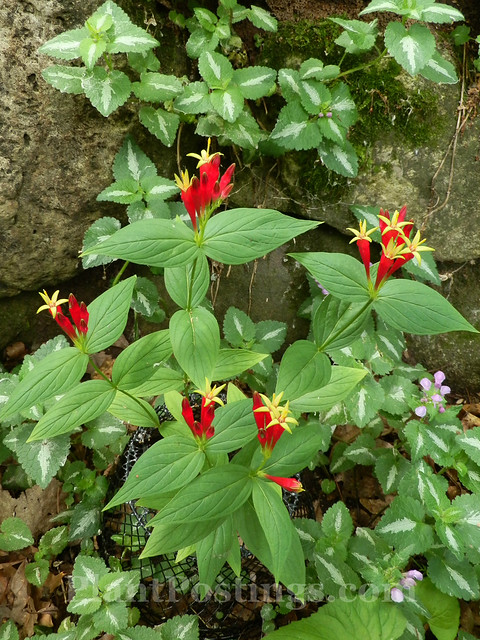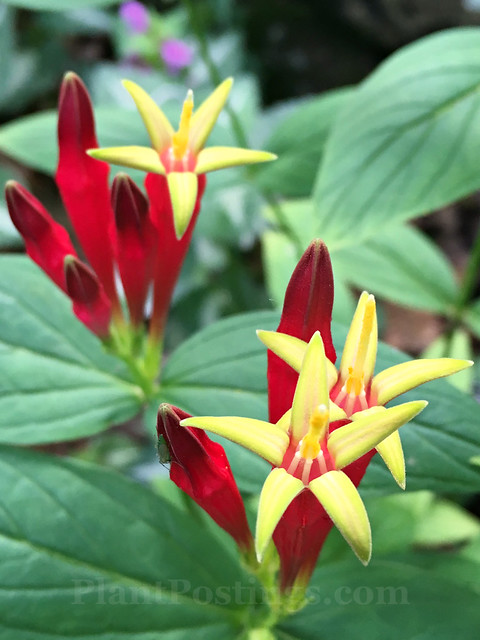 |
| Spigelia marilandica |
This month, I'm celebrating a plant that blooms with vibrant, bright color--even in shade. Woodland Pinkroot (Spigelia marilandica), also known as Indian Pink or Worm Grass, is new to my garden this year. It is not native to Wisconsin, but it's native just south of me in Illinois (and most of the Southeastern U.S.). It's hardy to zone 5 (USDA zones 5-9), and I love it, so I had to try it.
As often happens with new plants, this one came into my garden to fill a challenging spot. It's a north-facing area, shaded by small evergreens and large Honey Locust trees. The Pinkroot is doing OK there, but it's really taking off in a different location in the garden (of course!)--still north-facing, but at the base of the rock wall. I saved one plant for this spot. It will be interesting to see if any of the four plants come back next year.
Woodland Pinkroot likes dry to moist, acid-based, fertile soil, according to the Lady Bird Johnson Wildflower Center. It tolerates sandy to medium loam soils, and shade to woodland openings. The descriptions match my garden conditions nearly exactly, except that its native range is further south.
 |
| Green buds (fluff on foliage is from the neighborhood Cottonwood trees). |
It's exciting to see the first green buds appear, when you know what's coming next.
 |
| I like this stage! |
Before opening, and as they color, the buds appear pinkish. I really like this stage of the blooming cycle.
 |
| Not bad for first-year growth. I think it likes this spot by the rock wall. |
Then the flowers open to bright red and yellow splashes, loved by hummingbirds and butterflies. Depending on the light, I'm finding that the color of the tubular flower part varies from fuchsia-red to scarlet.
Pinkroot is said to form clumps, and spreads by rhizomes and seeds. It gets its nicknames from the historical use of its roots as treatment for intestinal worms. I'd read that deer and rabbits tend to avoid it, but just to be safe I caged it. And others have reported that rabbit-grazing can be an issue.
Plant height is 1-2 feet tall, and about the same spread at the top. While it blooms in the spring in the south, it's blooming in my garden for the month of June and likely beyond.
Stay tuned: I'll keep you posted next spring if it makes a repeat appearance. Until then, I'll be watching closely for hummingbird traffic on the plants.
 |
| Who can resist? |
To see more wildflowers blooming in gardens this June, visit Gail's Clay and Limestone for Wildflower Wednesday.
Beautiful! I definitely hope this lovely plant overwinters for you.
ReplyDeleteMe, too! I'm thinking it will do just fine by the rock wall, which is a mild microclimate. I'm not sure how it will do out in front, but I'll cover it and mulch it. I think I might add some large rocks out there, too, which would look nice and might help to keep it a little warmer.
DeleteOh I would love the have that wildflower!
ReplyDeleteIt is beautiful!
I know--I had to try it! Bright color in the shade is so hard to come by, and the more plants I can add for the hummingbirds, the better! :)
DeleteThe plants sure look good! I hope the hummingbirds find them, and that they do overwinter there.
ReplyDeleteI think the hummingbirds have found them. I see them over there frequently, but haven't had a chance to watch that part of the garden for an extended sit. ;-) The plants seem to love the garden--at least during the spring and summer so far.
DeleteImpressive growth and beautiful bloom. I hope this continues to spread and be happy in your garden.
ReplyDeleteThanks for your well-wishes, Peter. I hope so, too. It's always fun to try these experiments with plants--especially plants we love. :)
DeleteIt is amazing to see a woodland plant that is that colorful. Wowza!
ReplyDeleteI know! I actually feel a need for more color in the middle of summer when the green takes over the shade garden. I frequently walk around to the sunny sides of the lot to get my color fix. I'm so glad I learned about this plant from other garden bloggers. :)
DeleteI must follow the crowd and agree it is quite impressive!
ReplyDeleteJeannie
GetMeToTheCountry.Blogspot.com
It's hard to think otherwise--especially for a shade plant. I wish I'd discovered it years ago!
DeleteI have never seen this plant before, I love it.
ReplyDeleteI wasn't familiar with it either (or I thought I was much too far north for it) until a couple of years ago, when several Midwestern bloggers posted about it. I thank them for introducing it to me. :)
DeleteI have tried a couple of times to get this going and failed. I must not have the right soil. :(
ReplyDeleteYou probably have a better climate for it--slightly milder winters. That is my concern here, that it will simply not survive the cold of January. But it's worth a try for this beauty. :)
DeleteWow! I like the color, very unique.
ReplyDeleteYes, indeed. It's really exciting to see the buds developing and the color starting (yes, I am a certified plant nerd)!
DeleteWhat an amazing flower. I hope you get the hummingbird traffic (and then post lots of photos of them!).
ReplyDeleteI need to sit outside and watch them! The flowers are starting to fade now, but I'm going to deadhead and hopefully they'll re-bloom. I've heard that can work for a second flush.
DeleteLove seeing something new . . .
ReplyDeletePinkroot reminds me of firecrackers.
Buds and then Bursts . . .
Very nice . . .
Good comparison--they do look like fireworks! It is fun to learn about and try new plants! :)
DeleteYour Spigelias are doing great, considering it's only their first year! Mine have spread just a little bit in three years, but not much. My soil is not acidic, but I do use pine needles for some of the mulch, so perhaps that helps. I remember searching the internet for a source for these a few years ago and found Prairie Nursery, the only place that still had some in stock. That was a lucky find, because I've been very happy with their plants and shipping. Hope you see some hummers on them!
ReplyDeleteSo far, so good. You are closer to the normal range for them--so you are lucky! :) My soil is acidic because of all the decomposing leaves, so I guess it makes sense that this woodland plant would prefer that type of soil. Pine needles make sense, too. I had been planning to order these from Prairie Nursery or Prairie Moon, but they were sold out. So, believe it or not, I was able to find them at a local perennial nursery. The staffer had to hunt for them, and they looked like stubs with barely any growth when I bought them, but boy have they filled in! I'm very happy! I love Prairie Moon and Prairie Nursery, though, and have purchased many plants from them. Also, Agrecol.com. :)
DeleteI agree this is a pretty perennial, although it struggles here in the heat of summer. It did better this year after I transplanted it into a shadier location. Also, rabbits usually demolish the plants, but we have a peculiar lack of rabbits in the garden this year.
ReplyDeleteAlso, despite the fact that it *looks* like the flowers would be attractive to butterflies and hummingbirds, sadly I've never seen either pollinator visiting this plant :(
You're fortunate that you're in the native range. It makes sense that it would perform better in the shade, though. I caged these, and I think the fact that they put on most of their growth when the rabbits have other options has helped. Fingers crossed that this will keep working. I haven't seen butterflies on them, but I've seen the hummingbirds in that area. I have yet to actually capture one nectaring on the flowers--that would be awesome to see and photograph!
DeleteSuch a pretty flower. Here they bloom in May and are visited by the ruby-throated hummingbirds. Stay tuned, the seed capsules are interesting too.
ReplyDeleteI've noticed the hummingbirds in the area, so I'm thinking they're liking them. I'm looking forward to seeing the seed capsules--thanks for the tip!
DeleteFunny that we both posted on the same plant within a couple of days! Yours is looking good! I have never heard the common name "Woodland Pinkroot".
ReplyDeleteYes, I guess it makes sense because our gardens seem to be on roughly the same schedule this year. You were one of several people during the past couple of years who recommended this plant on your blog. Thanks! Apparently there are several nicknames for this plant.
DeleteI grew it when I lived in North Carolina, though I only had it a short time before I moved. It's a beautiful plant! I didn't know it was called Woodland Pinkroot, as mine was labeled Indian pink. Hope it attracts some hummers for you!
ReplyDeleteI think it did attract hummers! We have several nesting here this summer (although there are plenty of other nectar-rich plants and great habitat here). The Spigelias are finished blooming now, although I deadheaded them, and some people say they'll bloom again later in the season. Apparently there are several nicknames for this plant. :)
DeleteOne of my all-time favorite shade plants. Hard to find here, but native to Oklahoma. Performs great in the shade. I love it. It does attract hummingbirds too!~~Dee
ReplyDeleteI love it! I'm so glad that you and other bloggers posted about it! My only issue is that the slugs and earwigs like it, too. But my "stale beer traps" are helping to keep the damage to a minimum. (So many of my plants are falling prey to slugs and earwigs this year because of so much rain, but that's better than a drought!)
Delete